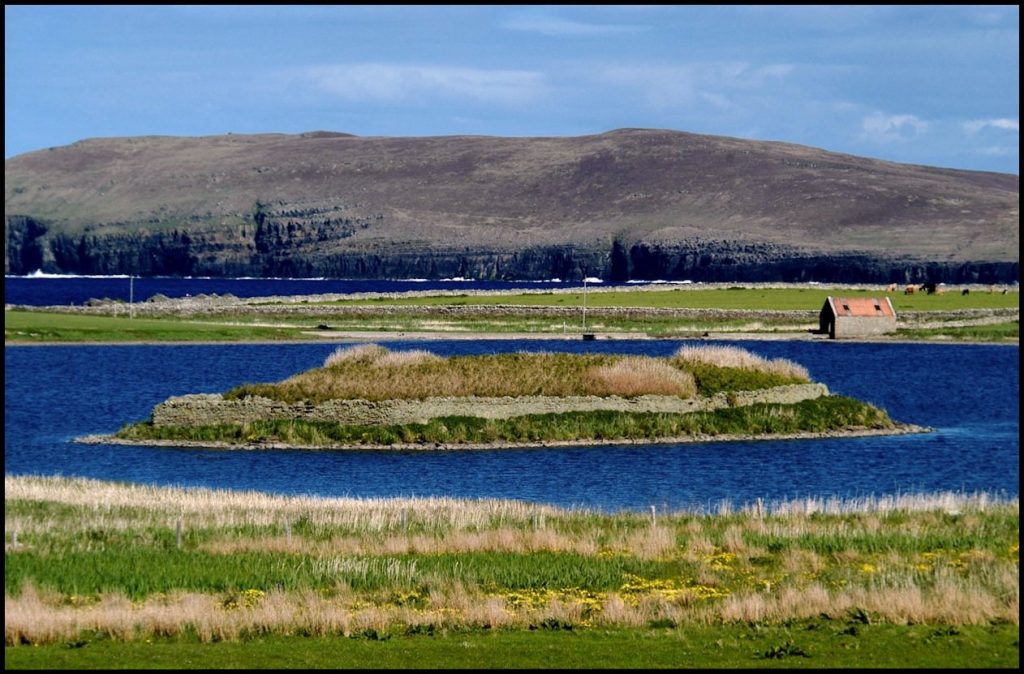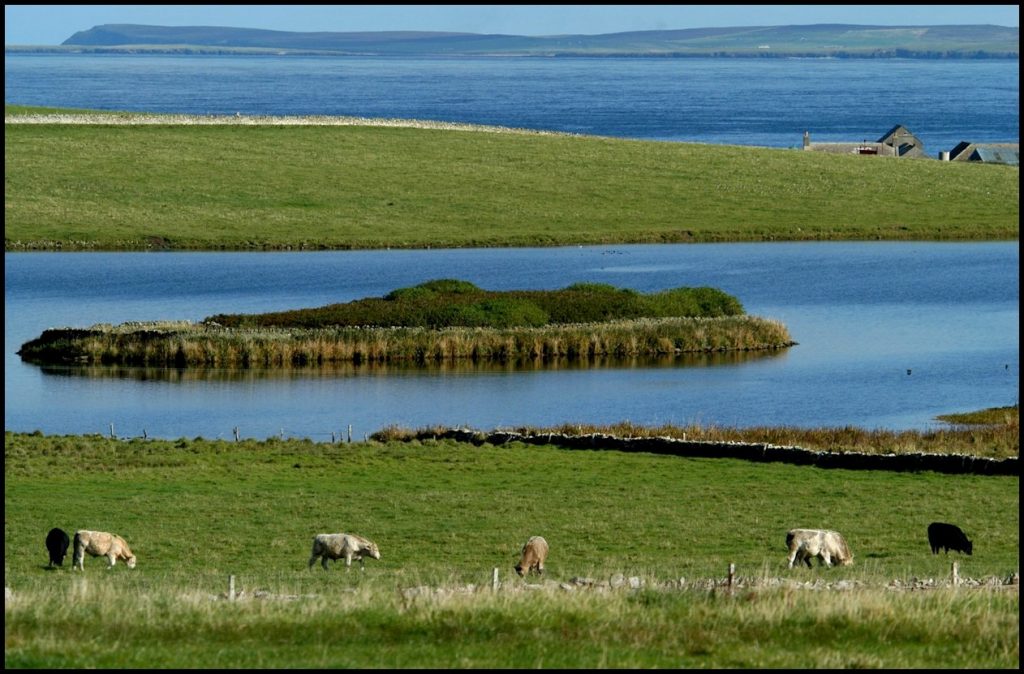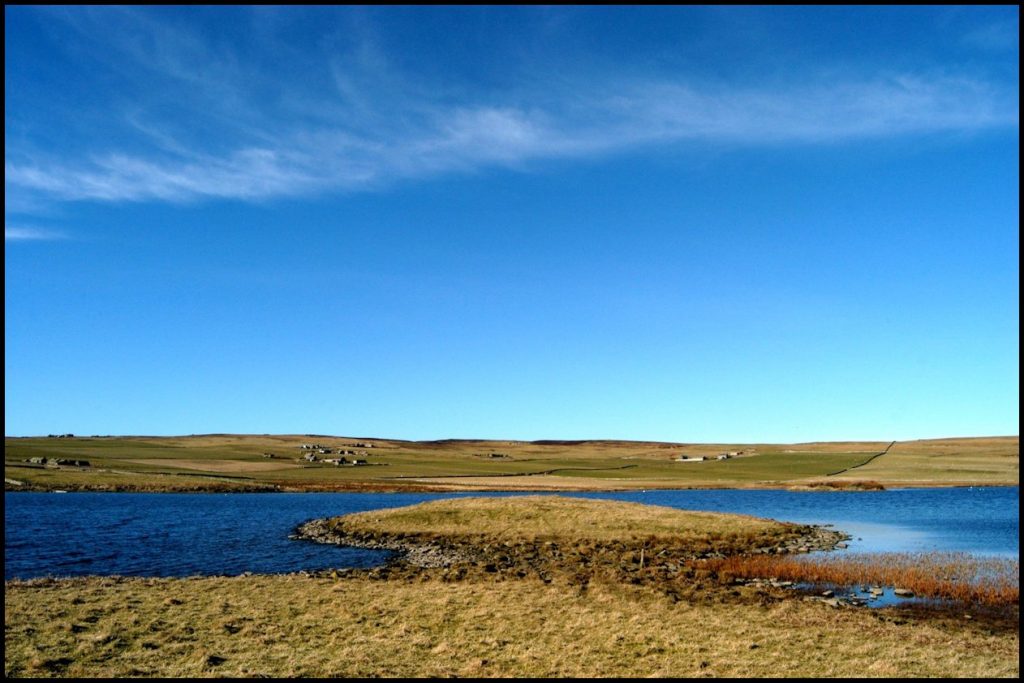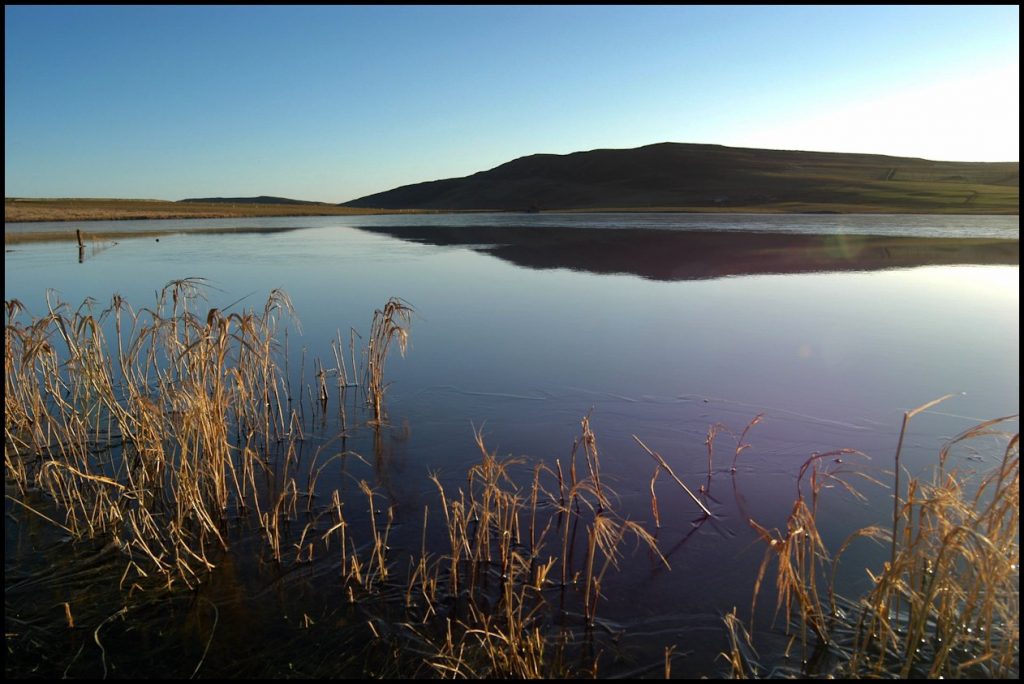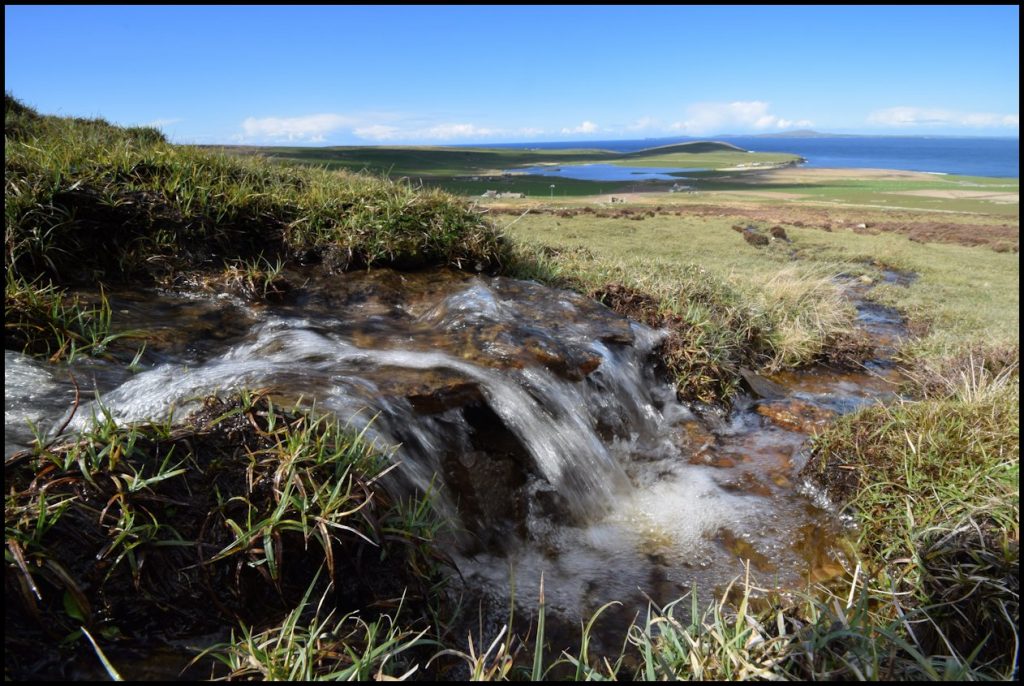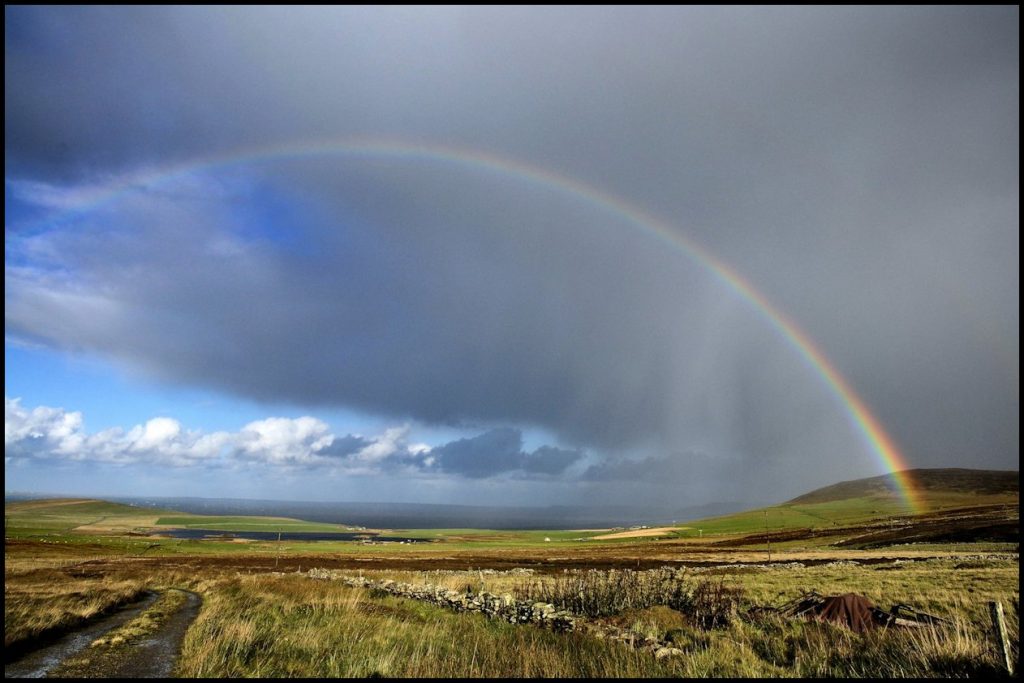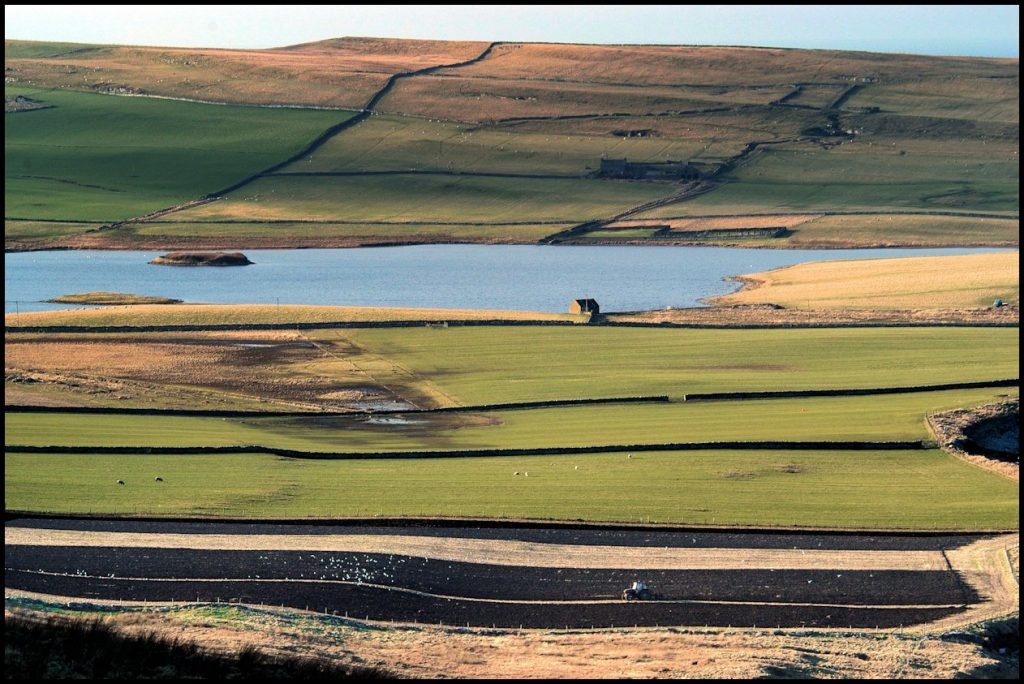Details of some of the ‘vanished’ houses and sites in Wasbister.
Bakicrass was the name of an ancient house in Wasbister. William Craigie and his wife Isabel Gibson lived there and James, their only child was born there on June 4th 1802.
Barebraes was a small croft in Wasbister on the hillside above Cogar.
Bleaching Knowe: On the southern shore of Wasbister Loch, immediately north of the school building, there is a much destroyed burnt mound which is locally called ‘The Bleaching Knowe’. There are also traces of cist-like boxes formed of slabs set on edge in and close to the water.
Burrian, applies to a small island or crannog situated in the Loch of Wasbister. It contains the site of an ancient chapel and was formerly connected with the mainland with stepping stones still visible under the surface of the loch. From the fact of deer horns, bones, coins etc having been found on the site of the old chapel, it is thought that a more ancient building existed there prior to the erection of the chapel.
Bretta Ness. A chapel formerly stood at this spot, a small promontory on the eastern side of the Loch of Wasbister. Its stones have been removed and placed on the margin of the loch. A gently rounded mound at the extremity of Bretta Ness may be the remains of this chapel; presumably the dedication was to St Brittiva, Bridget or Bride.
Bucket is the name of a vanished house in Wasbister; on record as being mentioned in the Rousay Birth Register of 1830.
Castal. In a field immediately to the north of the old house of Stennisgorn in Wasbister is a site known as the Castal. Here an old building once stood, and the late proprietor told Hugh Marwick that when his father was removing stones from the site he came upon a metal basin-shaped object. It was broken, but standing out in relief on its outside were figures of what he termed ‘an angel and a dragon’. The dragon ‘had scales marked on it.’ Some who saw it thought it might have been a bell, but from his description it must have been too shallow for such a purpose. It ‘lay about the house’ for some time, but he had lost sight of it for many years.
Corse Kirk. The present Wasbister kirkyard is beside the old chapel-site, and was apparently dedicated to The Holy Cross.
Easter Lee was a dwelling between Turbitail and Burness. In 1851 it was occupied by Mary Flaws, who used to earn a living as a straw plaiter, but by this time she was classed as a pauper.
Flottahall. Flotty was the name of a field on the south side of the road at Langskaill. An entry made in 1821 in the Rousay Birth Register records a house called Flottahall in Wasbister, and in the census of 1841 it was recorded as being somewhere between those of Whitemeadows and Langskaill. It was occupied by 40-year-old fisherman James Flaws and his 30-year-old wife Betty Barnetson. They had four children; James was born on July 22nd 1829 when they lived at Vacquoy. The other three were born at Flottahall; William, on May 27th 1831, Betsy Sutherland, on August 3rd 1834, and Margaret, who was born on August 25th 1836.
Gateside, another vanished house in Wasbister, was mentioned in the Birth Register in 1833.
Heather Hall was situated close to Blackhammer and Cubbidy on the hill above Wasbister and in the census of 1851 it was occupied by two families. Living at Heather Hall 1 was William Scott, a 28-year-old grocer and fisherman from North Ronaldsay, his wife Robina, who was 33 years of age, and their children; three-year-old William, and Ann, who was twelve months old. Jean Craigie lived at Heather Hall 2 with her son James. Jean was a 46-year-old stocking maker and her 22-year-old son earned a living as a fisherman. She was the widow of James Craigie, originally of ‘Giddystane, Wasbyster.’
Howatoft was the name of an old Wasbister house, probably in the neighbourhood of Saviskaill. In Heart’s Sasines is a record of a sale to Thomas Alexander, eldest lawful son of Henry Alexander in Saviskaill, by Katherin Brok, one of the lawful daughters and heirs portioners of James Brok in Howatow of her third of the halfpenny udal land under the house of Howatow in Wasbister. Sasine was given on March 5th 1624.
On April 26th 1625 Thomas Alexander obtained sasine on a charter to him from William Craigie of Papdale of 1 pennyland of udal land in Howatoft, of which half was called Brokeisland half Rigersland, which had been sold to him by James Craigie in Westray and Margaret Brok with consent of Magnus Hourston in Skabrae – heritors thereof. In 1634 William Craigie got a decree against Thomas Alexander’s widow for unpaid dues in respect of Howatoft, and two centuries later, in 1828, John Inkster had the cot-house of Howatoft included in his sasine of Saviskaill lands.
The Brok ownership of lands in Howatow and Howatoft seems to be sufficient proof that both names refer to the same property, and are only different forms of the same name. To Hugh Marwick the name seemed to point to an Old Norse hauga-topt, ‘taft of mounds,’ the site of some structure at or near mounds. He could not say definitely though that Howatoft actually meant a site marked by natural hillocks, or whether the mounds marked the ruins of previous structures, or whether they were perhaps prehistoric burial cairns, so-called picts-houses.
Lee was the name given to a dwelling, mentioned in the census of 1861 as being somewhere in the vicinity of Langskaill. It was occupied by 79-year-old agricultural labourer John Clouston and his 62-year-old wife Mary. Ten years previously they were living at nearby Claybank, and previous to that they lived at Croulay at Quandale.
Lerquoy was the name of a house in Wasbister built c1600. In 1733 William Yorston was the tenant, and when James Inkster was the tenant in 1840 he paid rent in kind, though by 1843 this had been established at the sum of £5.10.0. In 1847 Lerquoy was added to the farm of Quoys.
Lows House was in the neighbourhood of Feolquoy in Wasbister. It was most probably named after a family of that name, for the name Lowe is on record in Wasbister during the 17th century. In the 1840’s, it was occupied by shoemaker Alexander Marwick and his family. Alexander was paying £4.11.6. rent for Loweshouse and half of Negar at this time. By 1851, the Marwicks had moved to Corse at Frotoft. Loweshouse was then occupied by Alexander Craigie and his wife Ann Murray, and it was not long before they moved into Feolquoy.
Meeran, or Quoymeeran, was an old house below Feolquoy in Wasbister occupied in 1814 by John Mowat.
Negar was an old farm in Wasbister, spelt Niagair in 1633, and Neager in 1657, and was situated on land close to that of Feolquoy. William and Elizabeth Marwick lived at Heatherhall, Wasbister, in the latter part of the 18th century. They had two daughters, Rebekah, who was born in 1797, and Christian, born on July 4th 1799. The family then moved to Negar, and it was there that Elizabeth gave birth to three more children; Alexander, on July 11th 1801, William, on May 17th 1803, and James, who was born on September 7th 1807.
Alexander Marwick married Isabella Gibson, the daughter of David Gibson and his second wife Jean Marwick of Langskaill, on March 6th 1829. Writing less than a dozen years after the Quandale clearance of 1845, Alexander remembered how “in summer the hills swarmed with horses, cattle, sheep, pigs and geese.” The 40 families between the Dyke of Grind, the southern boundary of Westness, and the Lobust, the northern limit of Quandale, owned 70 horses, 220 cattle and between 600 and 700 sheep. “There was more beef and mutton used in Rousay in one year,” he wrote, “than is now used in ten years.”
Roadside, a cottage in Wasbister near the school, was also known as Maybank. In 1861 37-year-old boat builder David Inkster and his family lived there. David, born on September 21st 1823, was the son of James Inkster and Barbara Mainland of Saviskaill. In 1849 he married Janet Gibson, daughter of Hugh Gibson and Janet Craigie of Skatequoy, who was born on September 26th 1826. They had three children; Hugh, born on February 27th 1850, Janet, born in 1863, and Agnes, who was born in 1868.
In 1871 65-year-old Betty Craigie lived at Roadside. She was the daughter of Drummond Craigie and Barbara Murray of Whoam, and she was born on July 29th 1805. Unmarried, she was employed as the island’s letter carrier, and was commonly referred to as ‘Post Betty’.
In 1881 Roadside was occupied by 30-year-old general labourer James Craigie. He was the son of Alexander Craigie and Ann Murray of Falquoy, and was born on July 11th 1850 at Loweshouse. On April 15th 1870 James married Janet Sinclair, daughter of Hugh Sinclair and Isabella Gibson of Stennisgorn, who was born on January 9th 1851. They had seven children: Annabella was born on June 7th 1872 at Falquoy, John, on March 30th 1875 at the Old School, Wasbister, as was Jessie Alexina, on April 25th 1879, Clara, on August 30th 1881, James, on April 13th 1884, and Sarah, on April 30th 1886.The youngest child was Alice who was born on December 10th 1891 at Falquoy.
Seaterquoy, mentioned in 1823 in the Rousay Birth Register, was a Wasbister house, long deserted and demolished, situated above Feolquoy.
Torcabreck was the name of an old house in Wasbister. Mary Flett, the first child of George Flett and Christian Inkster was born there on July 15th 1816. Their other children were born at nearby Hillhouse; Janet, in June 1819, and James, on September 11th 1822.
Toisterburn is the name of another vanished Wasbister house.
Upper Geo was the name of a dwelling in Wasbister. Hugh Craigie, who was born in about 1786, married Christian Gibson on January 22nd 1816 and their first two children were born at Upper Geo; Margaret, on October 15th 1821, and Sally on December 8th 1823. They had four more children who were born at nearby Castlehill; a second Sally, on November 16th 1825, Hugh, on July 12th 1829, Mary, on February 1st 1832, and James, who was born there on January 15th 1837.
Wasbister Field Names. Bregaday, on the north side of the Loch of Wasbister; Conquoy, a field name and also that of a geo on the shore north of Saviskaill; Kuiv at the NW corner of the Loch of Saviskaill; Kunquoy is another field name in this vicinity; Fauld, on the old farm of Stennisgorn; Fidge Meadow, a low-lying tract of ground on the north side of the public road below Vacquoy; Hungry Quoy, near Falquoy; Husen and Husmasay, near Skatequoy; Lamiger, near Skatequoy; The Nine Rigs at Langskaill running down to the shore east of the farmhouse; Owern, at Langskaill next to the Leean; Skooany, above Cogar; Swanaland, at Skatequoy; Flotty and the West Toon, at Langskaill.
Well of Ease was the name given to a fresh-water spring that bubbles up on the beach below Langskaill. Its origin is obscure; it is only a few hundred yards along the beach from the site of the ancient Colm’s Kirk – a ruinous chapel site of Celtic foundation, possibly dedicated to either St Colm of St Columba.

